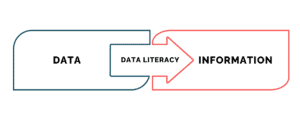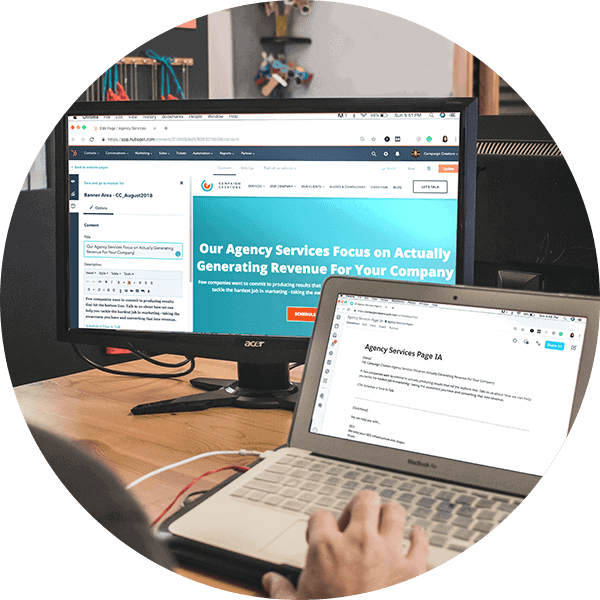
Avoid Clickbaits: Marketing Analytics Scam Emails
March 7, 2024
Why Your Company Needs Sales and Marketing Alignment Now More Than Ever
April 1, 2024Over the last several years, “data” has become a buzzword across the business landscape, with professionals at all levels and industries name-dropping it to convey they’re in the know. But here’s the striking truth: Findings from the State of Data Literacy 2023 Report show that only 5% of organizations consider themselves fully data literate. To put it bluntly, most businesses simply don’t know what to do with their data.
So, while there is a consensus that data is imperative for making informed decisions, there’s a gap between the perceived significance of data and its practical application within businesses.
How do we bridge this gap, then?
A Simple Misunderstanding: Data vs. Information
Data and information sound virtually the same, but the truth is that they profoundly differ. In fact, they represent the two ends of a straightforward process, where one emerges from the development of the other.
Data consists of raw statistics and facts, lacking organization or context. Hence, as standalone numbers, data carries no inherent meaning, purpose, or impact, and it fails to provide a comprehensive picture for decision-making. Examples of data include metrics such as the number of website visitors within a specific time frame, the number of likes on a social media post, or new clients acquired during a given period.
Information takes data to the next level. Unlike data, information is more organized and imparts context to individual figures and numbers (aka, data). Hence, information proves more valuable for decision-making processes. Examples of information include insights such as identifying trends in organic traffic to the website, analyzing the ratio of likes to comments or shares, and comparing the numbers of new clients over time.
The distinction between data vs. information clarifies their interdependence. Data without information is useless, whereas information cannot exist without data, and as a business, you need them both. But while data collection methods are pretty well-known, the big question is how to transform data into information.
Data Literacy: Transforming Data into Information
To turn data from interesting numbers to actionable insights, we need to bring into the process two factors that information has, and data lacks: context and interpretation. This is where data literacy comes in.
According to Harvard Business School, data literacy refers to one’s ability to read, understand, and utilize data in different ways. In essence, data literacy can be viewed as the driving force that propels the entire data analysis process forward. It empowers individuals to not only interpret data but also to apply it strategically, enabling them to extract valuable insights and make informed decisions.
For example, a spreadsheet of quarterly sales figures is just a set of numbers. But a data-literate professional can analyze it to reveal information/insights — comparing regional trends, identifying changing customer behaviors, discovering potential inventory issues, etc. Moreover, this enables the strategic application of the data by informing expansion plans, marketing campaigns, and hiring priorities.

Why Aren’t All Businesses Data-Literate?
Indeed, data literacy unlocks immense potential for optimizing strategies and crafting revenue-driven business plans. Unfortunately, though, not all businesses are data-literate.
For starters, since data is characterized as disorganized and context-lacking, many businesses don’t even know how to approach their data. Also, fears and misconceptions around data analysis may lead businesses to avoid facing data analytics challenges. Consequently, when it comes to marketing performance, companies refrain from delving into the depths of their marketing analytics, missing out on opportunities to leverage this knowledge for informed strategies.
However, data literacy does not require advanced technical skills like a data scientist, but rather, a basic knowledge of data concepts and applications. In other words, you don’t have to be a data expert to be data-literate. The truth is that even a minimal understanding of key marketing metrics and their significance can be enough to empower you with the confidence to make better marketing decisions.
How Waypost Marketing Promotes Data Literacy
At Waypost Marketing, we employ several avenues to encourage data literacy with our clients:
Monthly Meetings
When we work with clients, we make sure to hold routine monthly meetings where we go through the marketing analytics together. The goal of these meetings is not only to present the data as is, but also to provide a broader context. Specifically, we educate the client about the different marketing metrics we monitor, discuss how performance compares to prior months and established goals, and explain how these findings fuel decisions and marketing campaign optimization.
Nurturing data literacy among clients promotes more in-depth discussions about marketing activities and enhances clients’ sense of control over their marketing endeavors.
Explaining the Rationale Behind Marketing Strategies
As a data-driven marketing agency, we let data interpretation guide marketing strategies. That said, we don’t keep all this information to ourselves. As a marketing partner, it’s important to us that our clients remain informed about how their marketing dollars are spent. Therefore, we take the time to explain to clients precisely how and why decisions are made by showing the data trail.
For example, if a specific blog post consistently attracts more traffic over time, we show it to you and recommend creating more content around similar themes. Also, if certain user behaviors on a specific webpage are identified through heat map findings, we share this information and recommend strategic CTA placement. This sharing process allows clients to understand how data transforms into actionable strategies.
Educational Resources
At Waypost, our commitment to promoting data literacy extends beyond client education. To share our knowledge and assist more businesses in developing data literacy, we maintain an updated blog and resources page. Visitors can explore our diverse content on marketing trends and analytics, allowing them to enrich their marketing knowledge and ultimately build their data literacy skills.
Open Lines of Communication
Each and every team member of Waypost is determined to model the motives and actions of a trustworthy marketer. This is a core aspect of our brand purpose, so we take it seriously. Practically speaking, we are very transparent with your data and happy to discuss it!
Even outside of the monthly meetings or giving direct access to marketing reports, our team is prepared and available to answer our clients’ questions about their numbers and marketing strategies. For us, open and flowing communication fosters not only data literacy but also trust.
Make Data Literacy Your Priority
Data literacy is the indispensable link between raw data and informed strategy. Rather than get fixated on expanding data collection, priority must be placed on developing capabilities to contextualize, interpret, and apply that data to further business goals.
As for writing these lines, even the world’s most advanced computer cannot execute this task for you. It is the human capacity for critical and creative thinking, simultaneously integrating micro and macro perspectives to transform data in a vacuum into an actionable direction.
If you’re not sure where to start, check out our blog and resources page in the page’s top menu. For more information or a personalized consultation, don’t hesitate to contact us online or call us at 864-288-6162.








